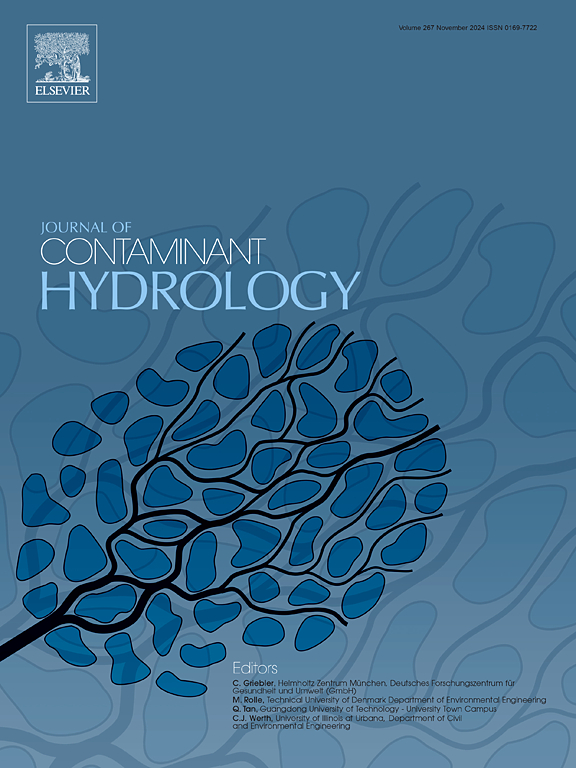在10 ~ 55°C的流动柱实验中,用NZVI去除四氯乙烯的温度效应
IF 3.5
3区 环境科学与生态学
Q2 ENVIRONMENTAL SCIENCES
引用次数: 0
摘要
城市地下储热的地下利用可以促进可持续和气候中性的供热。同时,频繁的底土污染提出了一个问题,即储存的热量是否可以用于修复,这可以从温度升高中受益(例如,通过增加反应性和解吸过程或加强微生物降解)。研究了适用于氯化烃修复的纳米级零价铁(NZVI)。然而,水温升高对地下水修复的潜在好处或缺点,包括污染物降解加速、长期反应性下降或受矿物沉淀影响的钝化过程,在很大程度上仍未得到探索。在此,我们研究了温度变化(10-55°C)对NZVI对四氯乙烯(PCE)长期降解的影响,采用柱实验来评估该方法与UTES耦合的适用性。使用去矿化水(DW),在10 ~ 55°C范围内,PCE的最大去除率(kPCE)从0.13提高到2.3 h−1。使用自来水(TW)时,kPCE在10 ~ 40°C范围内从0.18 h−1增加到0.75 h−1。由于更高的PCE去除率加上厌氧腐蚀增强导致的H2生成增加,长期腐蚀反应性在10至55°C之间从DW的~ 275至14天下降,在10至40°C之间从150至30天下降,因此增加的H2生成有利于微生物降解。在测试温度下,没有观察到碳酸盐沉淀导致的NZVI加速钝化。因此,实验表明,将UTES与NZVI结合进行修复是可行的,修复优势明显。本文章由计算机程序翻译,如有差异,请以英文原文为准。
Temperature effects for tetrachloroethylene removal with NZVI between 10 and 55 °C in flow-through column experiments
Subsurface utilization for underground thermal energy storage (UTES) in urban areas can promote a sustainable and climate-neutral heat supply. Meanwhile, frequent subsoil contamination raises the question of whether the stored heat could be used for remediation, which can benefit from increased temperatures (e.g., by increased reactivity and desorption processes or enhanced microbial degradation). We focus on nanoscale zerovalent iron (NZVI), which is suitable for chlorinated hydrocarbon remediation. However, the potential benefits or drawbacks of increased temperatures for groundwater remediation, including accelerated contaminant degradation, declining long-term reactivity, or influenced passivation processes by mineral precipitation, remain largely unexplored. Herein, we investigate the effect of temperature changes (10–55 °C) on NZVI's long-term degradation of tetrachloroethylene (PCE) using column experiments to assess the approach's suitability for coupling with UTES. Using demineralized water (DW), maximum PCE removal rates (kPCE) between 10 and 55 °C increased from 0.13 to 2.3 h−1. With tap water (TW), kPCE increased between 10 and 40 °C from 0.18 to 0.75 h−1. Due to the higher PCE removal rates in combination with increasing H2 generation caused by enhanced anaerobic corrosion, long-term corrosion reactivity decreased between 10 and 55 °C from ∼275 to 14 d with DW and from 150 to 30 d between 10 and 40 °C with TW, whereby the increased H2 formation is beneficial for microbial degradation. Accelerated passivation of the NZVI due to carbonate precipitation was not observed for the examined temperatures. Therefore, the experiments revealed that combining UTES with NZVI for remediation purposes is practicable, offering clear remediation advantages.
求助全文
通过发布文献求助,成功后即可免费获取论文全文。
去求助
来源期刊

Journal of contaminant hydrology
环境科学-地球科学综合
CiteScore
6.80
自引率
2.80%
发文量
129
审稿时长
68 days
期刊介绍:
The Journal of Contaminant Hydrology is an international journal publishing scientific articles pertaining to the contamination of subsurface water resources. Emphasis is placed on investigations of the physical, chemical, and biological processes influencing the behavior and fate of organic and inorganic contaminants in the unsaturated (vadose) and saturated (groundwater) zones, as well as at groundwater-surface water interfaces. The ecological impacts of contaminants transported both from and to aquifers are of interest. Articles on contamination of surface water only, without a link to groundwater, are out of the scope. Broad latitude is allowed in identifying contaminants of interest, and include legacy and emerging pollutants, nutrients, nanoparticles, pathogenic microorganisms (e.g., bacteria, viruses, protozoa), microplastics, and various constituents associated with energy production (e.g., methane, carbon dioxide, hydrogen sulfide).
The journal''s scope embraces a wide range of topics including: experimental investigations of contaminant sorption, diffusion, transformation, volatilization and transport in the surface and subsurface; characterization of soil and aquifer properties only as they influence contaminant behavior; development and testing of mathematical models of contaminant behaviour; innovative techniques for restoration of contaminated sites; development of new tools or techniques for monitoring the extent of soil and groundwater contamination; transformation of contaminants in the hyporheic zone; effects of contaminants traversing the hyporheic zone on surface water and groundwater ecosystems; subsurface carbon sequestration and/or turnover; and migration of fluids associated with energy production into groundwater.
 求助内容:
求助内容: 应助结果提醒方式:
应助结果提醒方式:


